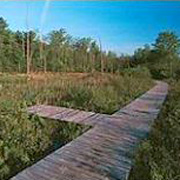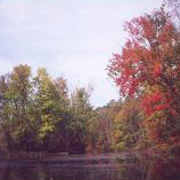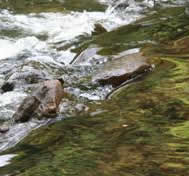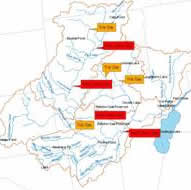
Senior Capstone Projects (2004-2005)
 An Analysis of the Kayaderosseras Creek as an Economic Resource
An Analysis of the Kayaderosseras Creek as an Economic Resource
Becky DiSciacca and Lexie Reiss (2005)
In this study, we have adopted an economic perspective to better understand the relationship between human activity and the natural ecosystem resources in the Kayaderasseras Creek watershed. A general overview of the economic benefits of ecosystem services in addition to a more specific focus on several ecosystem functions, namely aesthetics as well as tourism and recreation, help form a basis for understanding larger economic trends in this natural boundary area.
Full report is not available. Please contact Karen Kellogg for more information.
 Kayaderosseras Creek Watershed: An Examination of Land Use Patterns & Point and
Non-Point Pollution
Kayaderosseras Creek Watershed: An Examination of Land Use Patterns & Point and
Non-Point Pollution
James Caris and Laura Wittman (2005)
This project uses a series of GIS maps to visually convey point discharges as well as land use types that may contribute to non-point pollution within the watershed. Additionally, relevant state and federal permitting and policy procedures are included in order to highlight regulatory aspects applicable to facilities and land use that may affect the quality of the Kayaderosseras watershed.
 Quantifying Riparian Zones in the Kayaderosseras Watershed
Quantifying Riparian Zones in the Kayaderosseras Watershed
Hal Himmel (2005)
The focus of this study is to determine the overall state of riparian zones in the Kayaderosseras Creek watershed. Using GIS and field site verification, the land use patterns within 200 feet of the Kayaderosseras and its tributaries were quantified. These data give insights into the overall buffering capacity, habitat availability and possible areas of concern within the watershed.
Full report is not available. Please contact Karen Kellogg for more information.
 Macroinvertebrates as Water Quality Indicators in the Kayaderosseras Watershed
Macroinvertebrates as Water Quality Indicators in the Kayaderosseras Watershed
Leah Capezio and Lauren Mandel (2005)
This project investigated macroinvertebrate populations in microhabitats throughout the Kayaderosseras Creek watershed. Population, diversity and community composition data were analyzed through various indices as a means of assessing water quality throughout the watershed.
Full report is not available. Please contact Karen Kellogg for more information.
 Water Quality Analysis of the Kayaderosseras Creek
Water Quality Analysis of the Kayaderosseras Creek
David Hardy (2005)
Measurements of water quality, including pH, dissolved oxygen, salinity, turbidity, alkalinity as well as concentrations of chloride, nitrates and phosphates, were taken at various locations in the Kayaderosseras Creek system. Sampling was conducted to capture seasonal and pre-/post-storm event variation.
Full report is not available. Please contact Karen Kellogg for more information.
 The History of the Kayaderosseras Watershed: An Environmental Approach
The History of the Kayaderosseras Watershed: An Environmental Approach
Jon DeCoste and Conor Taff (2005)
Using various archival sources, a history of the Kayaderosseras watershed was constructed starting before European settlement and proceeding into the 20th century. The goal of this project is to illuminate historical trends and changes that have shaped the environment that we see today and to provide valuable insight into future monitoring and planning.
Summer Collaborative Research (2005)
 Blessed with Water: Politicising Resource Management in a Water Rich Area of Upstate
New York
Blessed with Water: Politicising Resource Management in a Water Rich Area of Upstate
New York
Allison Stafford '07, Erin Black '06, Michael C. Ennis-McMillan, Department of Anthropology, and Karen Kellogg, Department of Biology and Environmental Studies Program (2005)
In recent years, Saratoga Springs, New York has experienced increased pressure on water resources, as the population increases and as water sources dwindle. We analyzed the potentially competing interests of civic groups, businesses and corporations, individuals and homeowners, and political officials from the city and county. Water is viewed as a very powerful natural resource that potentially influences development, economic advancement, political positioning, and the City's composition and character.
Full report is not available. Please contact Karen Kellogg for more information.
Independent Study Projects (2004-2005)
The Impact of Turbidity on Sunfish Foraging Efficiencies
Jon DeCoste '05, Doug Morin '07, Jorie Pollak '04 and Conor Taff '05 (2005)
We conducted a series of experiments to evaluate the impact of various turbidity levels on juvenile bluegill sunfish foraging efficiencies. We found that foraging efficiencies are highest at intermediate turbidity levels, and drop significantly at low and high turbidity levels. We hypothesize that the decrease in foraging efficiencies in clearer water is due to predator avoidance, while the decrease in foraging efficiencies at higher turbidity levels is due to the poor visual environment.
Full report is not available. Please contact Karen Kellogg for more information.
 A Survey of the Surficial and Bedrock Geology of the Kayaderosseras Watershed
A Survey of the Surficial and Bedrock Geology of the Kayaderosseras Watershed
Conor Taff '05 (2005)
The aim of this project was to provide a basic GIS database of relevant maps and layers
of the Kayaderosseras watershed as a foundation for future WRI research. Detailed
maps and layers of the Kayaderosseras watershed were created, including subwatershed
divisions, topography, municipal boundaries, land use, roadways, bedrock geology and
surficial geology. This project also includes an overview of the geologic history
of Kayaderosseras watershed.